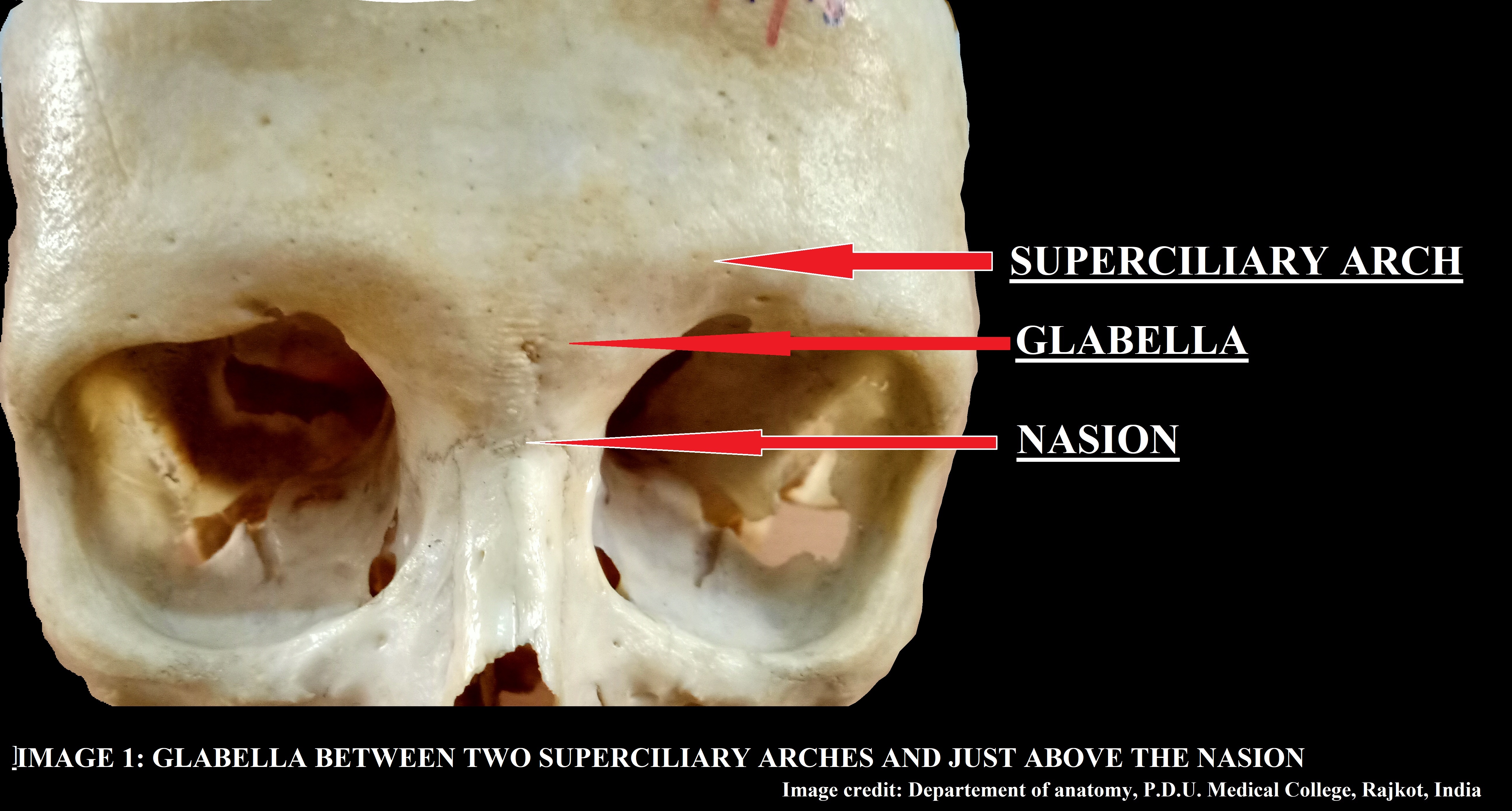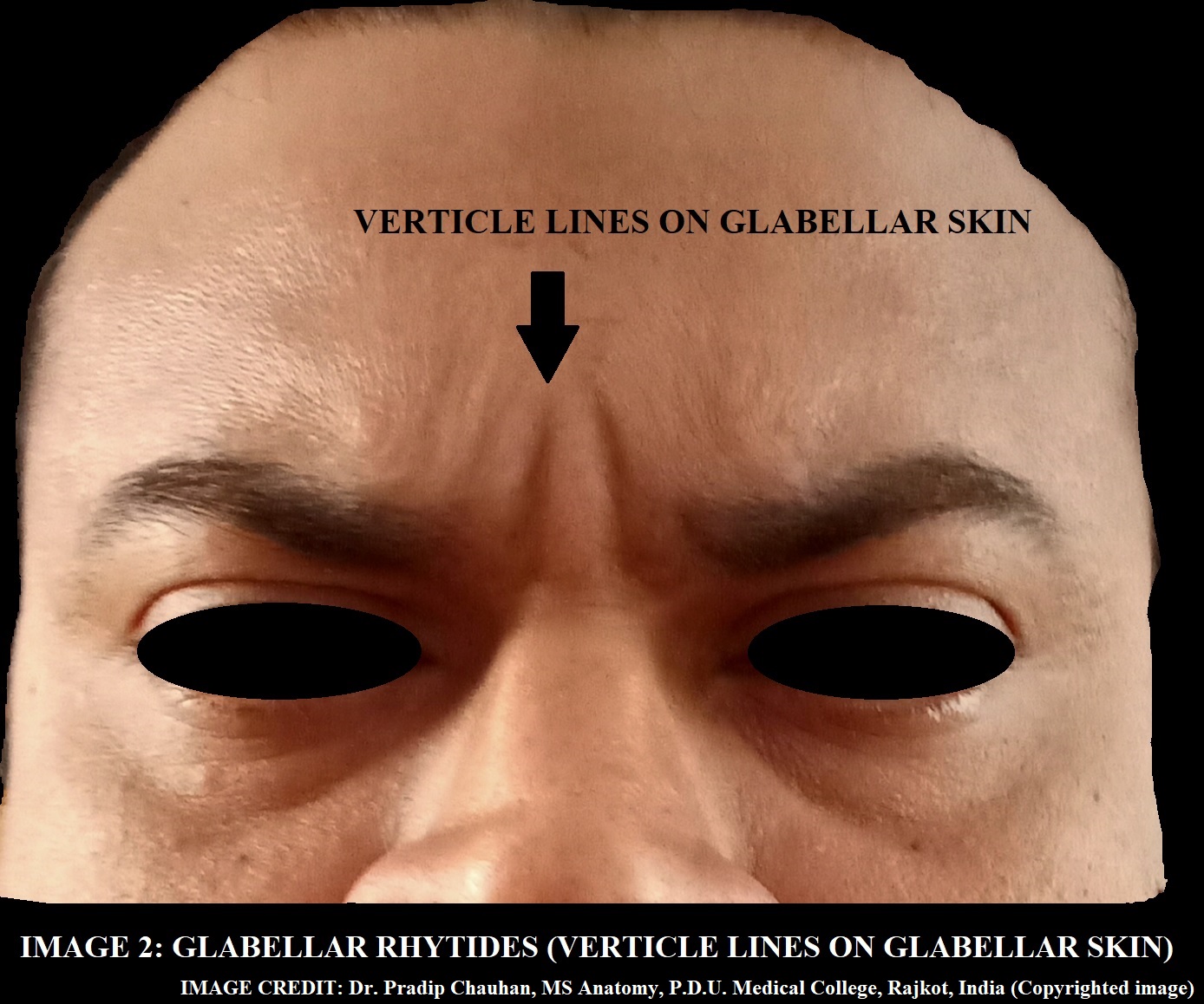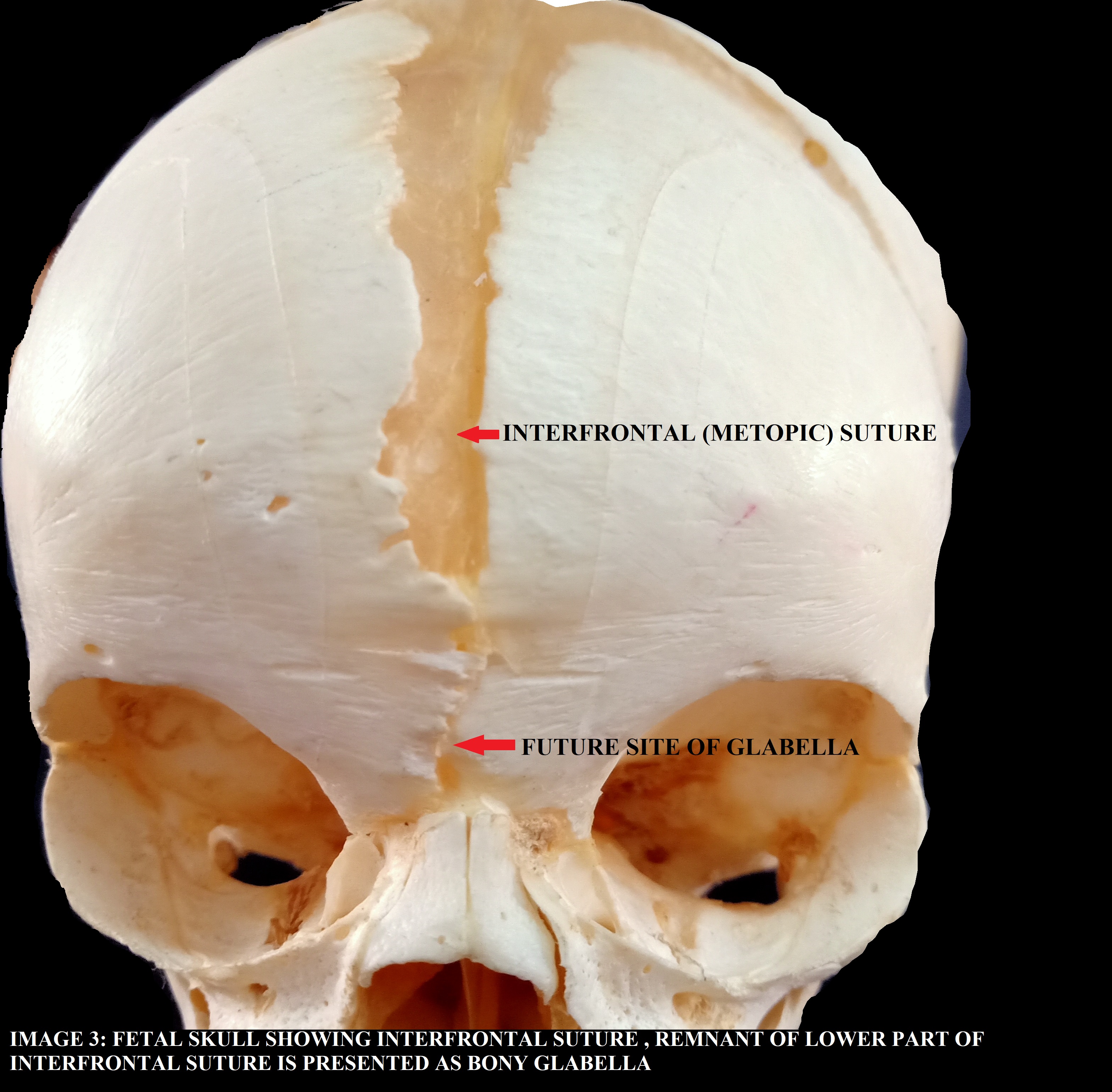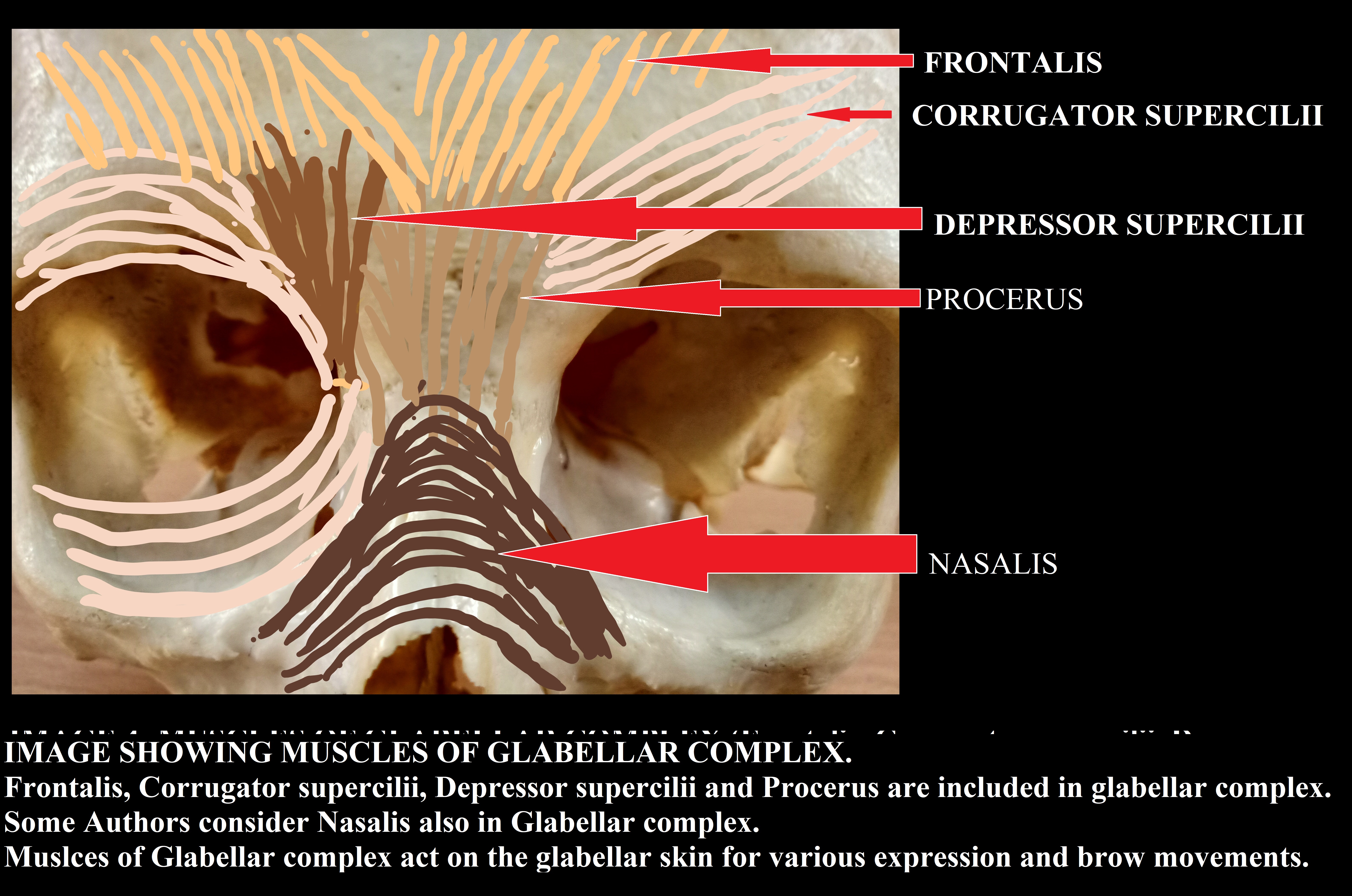[1]
Sanjuan-Sanjuan A, Ogledzki M, Ramirez CA. Glabellar Flaps for Reconstruction of Skin Defects. Atlas of the oral and maxillofacial surgery clinics of North America. 2020 Mar:28(1):43-48. doi: 10.1016/j.cxom.2019.11.004. Epub
[PubMed PMID: 32008708]
[2]
Schlager S, Kostunov J, Henn D, Stark BG, Iblher N. A 3D Morphometrical Evaluation of Brow Position After Standardized Botulinum Toxin A Treatment of the Forehead and Glabella. Aesthetic surgery journal. 2019 Apr 8:39(5):553-564. doi: 10.1093/asj/sjy205. Epub
[PubMed PMID: 30124769]
[3]
De Rose J, Laing B, Ahmad M. Skull Abnormalities in Cadavers in the Gross Anatomy Lab. BioMed research international. 2020:2020():7837213. doi: 10.1155/2020/7837213. Epub 2020 Feb 19
[PubMed PMID: 32149137]
[4]
Arnaud E, Renier D, Marchac D. Development of the frontal sinus and glabellar morphology after frontocranial remodeling for craniosynostosis in infancy. The Journal of craniofacial surgery. 1994 May:5(2):81-92; discussion 93-4
[PubMed PMID: 7918861]
[5]
Godde K, Thompson MM, Hens SM. Sex estimation from cranial morphological traits: Use of the methods across American Indians, modern North Americans, and ancient Egyptians. Homo : internationale Zeitschrift fur die vergleichende Forschung am Menschen. 2018 Sep:69(5):237-247. doi: 10.1016/j.jchb.2018.09.003. Epub 2018 Sep 21
[PubMed PMID: 30269926]
[6]
Knize DM. Muscles that act on glabellar skin: a closer look. Plastic and reconstructive surgery. 2000 Jan:105(1):350-61
[PubMed PMID: 10627005]
[7]
Abramo AC, Do Amaral TP, Lessio BP, De Lima GA. Anatomy of Forehead, Glabellar, Nasal and Orbital Muscles, and Their Correlation with Distinctive Patterns of Skin Lines on the Upper Third of the Face: Reviewing Concepts. Aesthetic plastic surgery. 2016 Dec:40(6):962-971
[PubMed PMID: 27743084]
[8]
Brown TM, Drake TM, Krishnamurthy K. Anatomy, Head and Neck, Procerus Muscle. StatPearls. 2023 Jan:():
[PubMed PMID: 30521184]
[9]
Lorenc ZP, Smith S, Nestor M, Nelson D, Moradi A. Understanding the functional anatomy of the frontalis and glabellar complex for optimal aesthetic botulinum toxin type A therapy. Aesthetic plastic surgery. 2013 Oct:37(5):975-83. doi: 10.1007/s00266-013-0178-1. Epub 2013 Jul 12
[PubMed PMID: 23846022]
Level 3 (low-level) evidence
[10]
Kamat A, Quadros T. An observational study on glabellar wrinkle patterns in Indians. Indian journal of dermatology, venereology and leprology. 2019 Mar-Apr:85(2):182-189. doi: 10.4103/ijdvl.IJDVL_211_17. Epub
[PubMed PMID: 29620040]
Level 2 (mid-level) evidence
[11]
Jiang H, Zhou J, Chen S. Different Glabellar Contraction Patterns in Chinese and Efficacy of Botulinum Toxin Type A for Treating Glabellar Lines: A Pilot Study. Dermatologic surgery : official publication for American Society for Dermatologic Surgery [et al.]. 2017 May:43(5):692-697. doi: 10.1097/DSS.0000000000001045. Epub
[PubMed PMID: 28244900]
Level 3 (low-level) evidence
[12]
Jia Z, Lu H, Yang X, Jin X, Wu R, Zhao J, Chen L, Qi Z. Adverse Events of Botulinum Toxin Type A in Facial Rejuvenation: A Systematic Review and Meta-Analysis. Aesthetic plastic surgery. 2016 Oct:40(5):769-77. doi: 10.1007/s00266-016-0682-1. Epub 2016 Aug 5
[PubMed PMID: 27495260]
Level 2 (mid-level) evidence
[13]
Abramo AC. Anatomy of the forehead muscles: the basis for the videoendoscopic approach in forehead rhytidoplasty. Plastic and reconstructive surgery. 1995 Jun:95(7):1170-7
[PubMed PMID: 7761503]
[14]
Abramo AC. Muscle Insertion and Strength of the Muscle Contraction as Guidelines to Enhance Duration of the Botulinum Toxin Effect in the Upper Face. Aesthetic plastic surgery. 2018 Oct:42(5):1379-1387. doi: 10.1007/s00266-018-1157-3. Epub 2018 Jul 9
[PubMed PMID: 29987485]
[15]
Fuchs A, Inthal A, Herrmann D, Cheng S, Nakatomi M, Peters H, Neubüser A. Regulation of Tbx22 during facial and palatal development. Developmental dynamics : an official publication of the American Association of Anatomists. 2010 Nov:239(11):2860-74. doi: 10.1002/dvdy.22421. Epub
[PubMed PMID: 20845426]
[17]
Weinzweig J, Kirschner RE, Farley A, Reiss P, Hunter J, Whitaker LA, Bartlett SP. Metopic synostosis: Defining the temporal sequence of normal suture fusion and differentiating it from synostosis on the basis of computed tomography images. Plastic and reconstructive surgery. 2003 Oct:112(5):1211-8
[PubMed PMID: 14504503]
[18]
Boyajian MK, Al-Samkari H, Nguyen DC, Naidoo S, Woo AS. Partial Suture Fusion in Nonsyndromic Single-Suture Craniosynostosis. The Cleft palate-craniofacial journal : official publication of the American Cleft Palate-Craniofacial Association. 2020 Apr:57(4):499-505. doi: 10.1177/1055665620902299. Epub 2020 Feb 4
[PubMed PMID: 32013562]
[19]
Frisdal A, Trainor PA. Development and evolution of the pharyngeal apparatus. Wiley interdisciplinary reviews. Developmental biology. 2014 Nov-Dec:3(6):403-18. doi: 10.1002/wdev.147. Epub 2014 Aug 29
[PubMed PMID: 25176500]
[20]
Kim B, Inoue Y, Imanishi N, Chang H, Shimizu Y, Okumoto T, Kishi K. Anatomical Study of Perfusion of a Periosteal Flap with a Lateral Pedicle. Plastic and reconstructive surgery. Global open. 2017 Sep:5(9):e1476. doi: 10.1097/GOX.0000000000001476. Epub 2017 Sep 19
[PubMed PMID: 29062647]
[21]
Khan TT, Colon-Acevedo B, Mettu P, DeLorenzi C, Woodward JA. An Anatomical Analysis of the Supratrochlear Artery: Considerations in Facial Filler Injections and Preventing Vision Loss. Aesthetic surgery journal. 2017 Feb:37(2):203-208. doi: 10.1093/asj/sjw132. Epub 2016 Aug 16
[PubMed PMID: 27530765]
[22]
Bonasia S, Bojanowski M, Robert T. Embryology and anatomical variations of the ophthalmic artery. Neuroradiology. 2020 Feb:62(2):139-152. doi: 10.1007/s00234-019-02336-4. Epub 2019 Dec 20
[PubMed PMID: 31863143]
[23]
Toma N. Anatomy of the Ophthalmic Artery: Embryological Consideration. Neurologia medico-chirurgica. 2016 Oct 15:56(10):585-591
[PubMed PMID: 27298261]
[26]
Hanick A, Ciolek P, Fritz M. Angular Vessels for Free-Tissue Transfer in Head and Neck Reconstruction: Clinical Outcomes. The Laryngoscope. 2020 Nov:130(11):2589-2592. doi: 10.1002/lary.28540. Epub 2020 Feb 19
[PubMed PMID: 32073659]
Level 2 (mid-level) evidence
[28]
Choi DY, Bae JH, Youn KH, Kim W, Suwanchinda A, Tanvaa T, Kim HJ. Topography of the dorsal nasal artery and its clinical implications for augmentation of the dorsum of the nose. Journal of cosmetic dermatology. 2018 Aug:17(4):637-642. doi: 10.1111/jocd.12720. Epub 2018 Jul 29
[PubMed PMID: 30058278]
[29]
Berger DMS, van Veen MM, Madu MF, van Akkooi ACJ, Vogel WV, Balm AJM, Klop WMC. Parotidectomy in patients with head and neck cutaneous melanoma with cervical lymph node involvement. Head & neck. 2019 Jul:41(7):2264-2270. doi: 10.1002/hed.25670. Epub 2019 Feb 14
[PubMed PMID: 30762921]
[30]
Wiener M, Uren RF, Thompson JF. Lymphatic drainage patterns from primary cutaneous tumours of the forehead: refining the recommendations for selective neck dissection. Journal of plastic, reconstructive & aesthetic surgery : JPRAS. 2014 Aug:67(8):1038-44. doi: 10.1016/j.bjps.2014.04.017. Epub 2014 May 20
[PubMed PMID: 24927861]
[32]
Li L, London NR Jr, Prevedello DM, Carrau RL. Intraconal Anatomy of the Anterior Ethmoidal Neurovascular Bundle: Implications for Surgery in the Superomedial Orbit. American journal of rhinology & allergy. 2020 May:34(3):394-400. doi: 10.1177/1945892420901630. Epub 2020 Jan 23
[PubMed PMID: 31973546]
[34]
Alouf E, Murphy T, Alouf G. Botulinum Toxin Type A: Evaluation of Onset and Satisfaction. Plastic surgical nursing : official journal of the American Society of Plastic and Reconstructive Surgical Nurses. 2019 Oct/Dec:39(4):148-156. doi: 10.1097/PSN.0000000000000287. Epub
[PubMed PMID: 31790044]
[35]
Hur MS. Anatomical relationships of the procerus with the nasal ala and the nasal muscles: transverse part of the nasalis and levator labii superioris alaeque nasi. Surgical and radiologic anatomy : SRA. 2017 Aug:39(8):865-869. doi: 10.1007/s00276-017-1817-z. Epub 2017 Jan 28
[PubMed PMID: 28132092]
[36]
Krüger GC, L'Abbé EN, Stull KE, Kenyhercz MW. Erratum to: Sexual dimorphism in cranial morphology among modern South Africans. International journal of legal medicine. 2015 Nov:129(6):1285. doi: 10.1007/s00414-015-1233-z. Epub
[PubMed PMID: 26210635]
[37]
Manthey L, Jantz RL, Bohnert M, Jellinghaus K. Secular change of sexually dimorphic cranial variables in Euro-Americans and Germans. International journal of legal medicine. 2017 Jul:131(4):1113-1118. doi: 10.1007/s00414-016-1469-2. Epub 2016 Oct 18
[PubMed PMID: 27757580]
[38]
Krüger GC, L'Abbé EN, Stull KE, Kenyhercz MW. Sexual dimorphism in cranial morphology among modern South Africans. International journal of legal medicine. 2015 Jul:129(4):869-75. doi: 10.1007/s00414-014-1111-0. Epub 2014 Nov 14
[PubMed PMID: 25394745]
[39]
Casado AM. Quantifying Sexual Dimorphism in the Human Cranium: A Preliminary Analysis of a Novel Method. Journal of forensic sciences. 2017 Sep:62(5):1259-1265. doi: 10.1111/1556-4029.13441. Epub 2017 May 26
[PubMed PMID: 28547887]
[40]
Alexander SL, Rafaels K, Gunnarsson CA, Weerasooriya T. Structural analysis of the frontal and parietal bones of the human skull. Journal of the mechanical behavior of biomedical materials. 2019 Feb:90():689-701. doi: 10.1016/j.jmbbm.2018.10.035. Epub 2018 Nov 1
[PubMed PMID: 30530225]
[41]
Hatipoglu HG, Ozcan HN, Hatipoglu US, Yuksel E. Age, sex and body mass index in relation to calvarial diploe thickness and craniometric data on MRI. Forensic science international. 2008 Nov 20:182(1-3):46-51. doi: 10.1016/j.forsciint.2008.09.014. Epub 2008 Nov 8
[PubMed PMID: 18996658]
[42]
Sabancıoğulları V, Koşar Mİ, Salk I, Erdil FH, Oztoprak I, Cimen M. Diploe thickness and cranial dimensions in males and females in mid-Anatolian population: an MRI study. Forensic science international. 2012 Jun 10:219(1-3):289.e1-7. doi: 10.1016/j.forsciint.2011.11.033. Epub 2011 Dec 23
[PubMed PMID: 22197522]
[43]
Ajwa N, Alkhars FA, AlMubarak FH, Aldajani H, AlAli NM, Alhanabbi AH, Alsulaiman SA, Divakar DD. Correlation Between Sex and Facial Soft Tissue Characteristics Among Young Saudi Patients with Various Orthodontic Skeletal Malocclusions. Medical science monitor : international medical journal of experimental and clinical research. 2020 Feb 26:26():e919771. doi: 10.12659/MSM.919771. Epub 2020 Feb 26
[PubMed PMID: 32101535]
[44]
Smith SL, Buschang PH. Midsagittal facial tissue thicknesses of children and adolescents from the Montreal growth study. Journal of forensic sciences. 2001 Nov:46(6):1294-302
[PubMed PMID: 11714138]
[45]
Pithon MM, Rodrigues Ribeiro DL, Lacerda dos Santos R, Leite de Santana C, Pedrosa Cruz JP. Soft tissue thickness in young north eastern Brazilian individuals with different skeletal classes. Journal of forensic and legal medicine. 2014 Feb:22():115-20. doi: 10.1016/j.jflm.2013.09.014. Epub 2013 Oct 3
[PubMed PMID: 24485435]
[46]
Cha KS. Soft-tissue thickness of South Korean adults with normal facial profiles. Korean journal of orthodontics. 2013 Aug:43(4):178-85. doi: 10.4041/kjod.2013.43.4.178. Epub 2013 Aug 22
[PubMed PMID: 24015387]
[47]
Kim JY, Kau CH, Christou T, Ovsenik M, Guk Park Y. Three-dimensional Analysis of Normal Facial Morphologies of Asians and Whites: A Novel Method of Quantitative Analysis. Plastic and reconstructive surgery. Global open. 2016 Sep:4(9):e865
[PubMed PMID: 27757330]
[49]
Hwang K. Revisiting the Skin Lines on the Forehead and Glabellar Area. The Journal of craniofacial surgery. 2018 Jan:29(1):209-211. doi: 10.1097/SCS.0000000000004073. Epub
[PubMed PMID: 29077679]
[50]
Kim HS, Kim C, Cho H, Hwang JY, Kim YS. A study on glabellar wrinkle patterns in Koreans. Journal of the European Academy of Dermatology and Venereology : JEADV. 2014 Oct:28(10):1332-9. doi: 10.1111/jdv.12286. Epub 2013 Oct 30
[PubMed PMID: 24168325]
[51]
Caminer DM, Newman MI, Boyd JB. Angular nerve: new insights on innervation of the corrugator supercilii and procerus muscles. Journal of plastic, reconstructive & aesthetic surgery : JPRAS. 2006:59(4):366-72
[PubMed PMID: 16756251]
[52]
Hwang K. Surgical anatomy of the facial nerve relating to facial rejuvenation surgery. The Journal of craniofacial surgery. 2014 Jul:25(4):1476-81. doi: 10.1097/SCS.0000000000000577. Epub
[PubMed PMID: 24926717]
[53]
Phumyoo T, Jiirasutat N, Jitaree B, Rungsawang C, Uruwan S, Tansatit T. Anatomical and Ultrasonography-Based Investigation to Localize the Arteries on the Central Forehead Region During the Glabellar Augmentation Procedure. Clinical anatomy (New York, N.Y.). 2020 Apr:33(3):370-382. doi: 10.1002/ca.23516. Epub 2019 Nov 21
[PubMed PMID: 31688989]
[54]
Cong LY, Phothong W, Lee SH, Wanitphakdeedecha R, Koh I, Tansatit T, Kim HJ. Topographic Analysis of the Supratrochlear Artery and the Supraorbital Artery: Implication for Improving the Safety of Forehead Augmentation. Plastic and reconstructive surgery. 2017 Mar:139(3):620e-627e. doi: 10.1097/PRS.0000000000003060. Epub
[PubMed PMID: 28234824]
[55]
Valladares-Narganes LM, Pérez-Bustillo A, Pérez-Paredes G, Rodríguez-Prieto MÁ. Combination of a glabellar flap and a transposition flap for the reconstruction of 2 noncontiguous nasal defects. Actas dermo-sifiliograficas. 2014 Mar:105(2):193-5. doi: 10.1016/j.ad.2013.10.006. Epub 2013 Dec 20
[PubMed PMID: 24360727]
[56]
Pollard WL, Xia Y, Sorace M. Repair of a Large Glabellar/Nasal Defect. Dermatologic surgery : official publication for American Society for Dermatologic Surgery [et al.]. 2019 Dec:45(12):1673-1676. doi: 10.1097/DSS.0000000000001734. Epub
[PubMed PMID: 30550516]
[57]
Konofaos P, Alvarez S, McKinnie JE, Wallace RD. Nasal Reconstruction: A Simplified Approach Based on 419 Operated Cases. Aesthetic plastic surgery. 2015 Feb:39(1):91-9. doi: 10.1007/s00266-014-0417-0. Epub 2014 Nov 21
[PubMed PMID: 25413009]
Level 3 (low-level) evidence
[59]
Goodman GJ, Armour KS, Kolodziejczyk JK, Santangelo S, Gallagher CJ. Comparison of self-reported signs of facial ageing among Caucasian women in Australia versus those in the USA, the UK and Canada. The Australasian journal of dermatology. 2018 May:59(2):108-117. doi: 10.1111/ajd.12637. Epub 2017 Apr 10
[PubMed PMID: 28397327]
[60]
Hsieh DM, Zhong S, Tong X, Yuan C, Yang L, Yao AY, Zhou C, Wu Y. A Retrospective Study of Chinese-Specific Glabellar Contraction Patterns. Dermatologic surgery : official publication for American Society for Dermatologic Surgery [et al.]. 2019 Nov:45(11):1406-1413. doi: 10.1097/DSS.0000000000001808. Epub
[PubMed PMID: 30789513]
Level 2 (mid-level) evidence
[61]
Monheit G, Lin X, Nelson D, Kane M. Consideration of muscle mass in glabellar line treatment with botulinum toxin type A. Journal of drugs in dermatology : JDD. 2012 Sep:11(9):1041-5
[PubMed PMID: 23135645]
[62]
Goodman GD, Kaufman J, Day D, Weiss R, Kawata AK, Garcia JK, Santangelo S, Gallagher CJ. Impact of Smoking and Alcohol Use on Facial Aging in Women: Results of a Large Multinational, Multiracial, Cross-sectional Survey. The Journal of clinical and aesthetic dermatology. 2019 Aug:12(8):28-39
[PubMed PMID: 31531169]
Level 2 (mid-level) evidence
[63]
de Almeida AR, da Costa Marques ER, Banegas R, Kadunc BV. Glabellar contraction patterns: a tool to optimize botulinum toxin treatment. Dermatologic surgery : official publication for American Society for Dermatologic Surgery [et al.]. 2012 Sep:38(9):1506-15. doi: 10.1111/j.1524-4725.2012.02505.x. Epub 2012 Jul 16
[PubMed PMID: 22804914]
[64]
Trelles MA, Pardo L, Benedetto AV, García-Solana L, Torrens J. The significance of orbital anatomy and periocular wrinkling when performing laser skin resurfacing. Dermatologic surgery : official publication for American Society for Dermatologic Surgery [et al.]. 2000 Mar:26(3):279-86
[PubMed PMID: 10759810]
[65]
Alexis AF, Grimes P, Boyd C, Downie J, Drinkwater A, Garcia JK, Gallagher CJ. Racial and Ethnic Differences in Self-Assessed Facial Aging in Women: Results From a Multinational Study. Dermatologic surgery : official publication for American Society for Dermatologic Surgery [et al.]. 2019 Dec:45(12):1635-1648. doi: 10.1097/DSS.0000000000002237. Epub
[PubMed PMID: 31702594]
[66]
Ong AA, Sherris DA. Neurotoxins. Facial plastic surgery : FPS. 2019 Jun:35(3):230-238. doi: 10.1055/s-0039-1688844. Epub 2019 Jun 12
[PubMed PMID: 31189195]
[67]
Wang J, Su Y, Zhang J, Guo P, Huang C, Song B. A Randomized, Controlled Study Comparing Subbrow Blepharoplasty and Subbrow Blepharoplasty Combined with Periorbital Muscle Manipulation for Periorbital Aging Rejuvenation in Asians. Aesthetic plastic surgery. 2020 Jun:44(3):788-796. doi: 10.1007/s00266-020-01630-4. Epub 2020 Feb 18
[PubMed PMID: 32072216]
Level 1 (high-level) evidence
[68]
Yi DJ, Hwang S, Son J, Yushmanova I, Anson Spenta K, St Rose S. Real-World Safety And Effectiveness Of OnabotulinumtoxinA Treatment Of Crow's Feet Lines And Glabellar Lines: Results Of A Korean Postmarketing Surveillance Study. Clinical, cosmetic and investigational dermatology. 2019:12():851-856. doi: 10.2147/CCID.S227493. Epub 2019 Nov 19
[PubMed PMID: 31819582]
[69]
Ascher B, Rzany B, Kestemont P, Hilton S, Heckmann M, Bodokh I, Noah EM, Boineau D, Kerscher M, Volteau M, Le Berre P, Picaut P. Significantly Increased Patient Satisfaction Following Liquid Formulation AbobotulinumtoxinA Treatment in Glabellar Lines: FACE-Q Outcomes From a Phase 3 Clinical Trial. Aesthetic surgery journal. 2020 Aug 14:40(9):1000-1008. doi: 10.1093/asj/sjz248. Epub
[PubMed PMID: 31550352]
Level 1 (high-level) evidence
[70]
Quereshy FA. Rejuvenation of the Facial Upper Third. Atlas of the oral and maxillofacial surgery clinics of North America. 2016 Sep:24(2):xi. doi: 10.1016/j.cxom.2016.06.001. Epub 2016 Jul 9
[PubMed PMID: 27499478]
[71]
Starkman SJ, Sherris DA. Association of Corrugator Supercilii and Procerus Myectomy With Endoscopic Browlift Outcomes. JAMA facial plastic surgery. 2019 Sep 1:21(5):375-380. doi: 10.1001/jamafacial.2018.2084. Epub
[PubMed PMID: 31046060]
[73]
Salandy S, Rai R, Gutierrez S, Ishak B, Tubbs RS. Neurological examination of the infant: A Comprehensive Review. Clinical anatomy (New York, N.Y.). 2019 Sep:32(6):770-777. doi: 10.1002/ca.23352. Epub 2019 Mar 8
[PubMed PMID: 30848525]
[74]
Damasceno A, Delicio AM, Mazo DF, Zullo JF, Scherer P, Ng RT, Damasceno BP. Primitive reflexes and cognitive function. Arquivos de neuro-psiquiatria. 2005 Sep:63(3A):577-82
[PubMed PMID: 16172703]
[75]
Kobayashi S, Maki T, Kunimoto M. Clinical symptoms of bilateral anterior cerebral artery territory infarction. Journal of clinical neuroscience : official journal of the Neurosurgical Society of Australasia. 2011 Feb:18(2):218-22. doi: 10.1016/j.jocn.2010.05.013. Epub 2010 Dec 14
[PubMed PMID: 21159512]
[76]
Brodsky H, Dat Vuong K, Thomas M, Jankovic J. Glabellar and palmomental reflexes in Parkinsonian disorders. Neurology. 2004 Sep 28:63(6):1096-8
[PubMed PMID: 15452308]
[77]
Thomas RJ. Blinking and the release reflexes: are they clinically useful? Journal of the American Geriatrics Society. 1994 Jun:42(6):609-13
[PubMed PMID: 8201145]
[78]
Marterer-Travniczek A, Danielczyk W, Müller F, Simanyi M, Fischer P. Release signs in Parkinson's disease with and without dementia. Journal of neural transmission. Parkinson's disease and dementia section. 1992:4(3):207-12
[PubMed PMID: 1627254]




